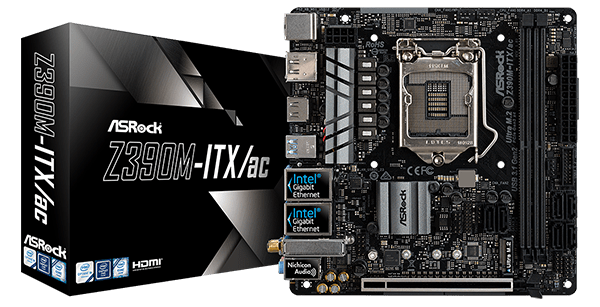Intel Z390 Motherboard Overview: 50+ Motherboards Analyzed
by Ian Cutress & Gavin Bonshor on October 8, 2018 10:53 AM EST- Posted in
- Motherboards
- Intel
- MSI
- Gigabyte
- ASRock
- EVGA
- Asus
- NZXT
- Supermicro
- Z390
ASRock Z390M ITX/ac
The ASRock is the only manufacturer to release two mini-ITX motherboards at the launch of the Z390 chipset and the Z390M ITX/ac stands out for quite a number of reasons. First of all the Z390M ITX/ac has dual Gigabit NIC with two LAN ports on the rear panel. Secondly, ASRock has managed to cram six SATA ports onto this board with every port featuring straight angled connectors. Memory support on the Z390M ITX/ac is provided from two RAM slots with a capacity of up to 32 GB and support for up to DDR4-4000.
Design wise the Z390M ITX/ac is very simplistic with what seems like a 6-phase power delivery which looks to be running in a 4+2 configuration. The heatsink doesn't look up to much, but the board does feature a single 8-pin 12 V ATX input which does show that the board is more than capable of running the new 9th generation Intel Core i9-9900K, but perhaps not with an overly aggressive overclock applied. There is no RGB LEDs integrated into the board which says this board is more aimed towards professional users and power users looking to build a high spec small form factor system without too much fluff. The board also features a single PCIe 3.0 full-length slot with ASRock Steel Slot reinforcement and just above is a single PCIe 3.0 x4/SATA M.2 slot.
On the rear panel are a pair of USB 3.1 Gen2 (Type-A and Type-C), four USB 3.0 Type-A and two USB 2.0 ports. Users running processors for the integrated graphics capabilities of the 8th and 9th generation Intel CPUs will be pleased to know the Z390M ITX/ac has dual HDMI outputs along with a single DisplayPort. A combo PS/2 keyboard/mouse port is ever present and the board uses a cheaper Realtek ALC887 HD audio codec which is supplemented by three 3.5 mm audio jacks. Wireless networking is supported through an Intel-based 802.11ac Wi-Fi adapter.
While the ASRock Z390M-ITX/ac shares similar traits as the Z390 Phantom Gaming-ITX/ac, the latter is aimed at gamers while the Z390M-ITX/ac is aimed more towards professional users. This is characterized by the inclusion of dual Intel LAN and a lower quality ALC892 audio codec. The price of the ASRock Z390M-ITX/ac is also another indicator with a recommended retail price of $150 along with the lack of gaming-themed stylings as the board features a basic, yet subtle aesthetic.












79 Comments
View All Comments
pawinda8 - Monday, October 15, 2018 - link
Still no mention of any Z390 boards with native Thunderbolt 3 (not AIC)! Has Intel given up on Thunderbolt for the PC world?gavbon - Monday, October 15, 2018 - link
If it's not integrated into the chipset, it's not really native as such. The ASRock Z390 Phantom Gaming-ITX/ac has a Thunderbolt 3 port on the rear panel, but that's the only one I'm afraidHikariWS - Monday, October 15, 2018 - link
Oculus Rift requires 3 USB3 ports and doesn't accept any of them being connected to a hub, they all need to be connected directly into a raw port. I had to buy a dedicated 3GIO USB 3 board that added 6 useful extra ports. In my (yes, old) Gigabyte z87 mobo I also had issues using keyboard and mouse on USB 3 ports inside UEFI and some recovery softwares, so I had to buy a USB 2 mirror to connect them.Because of that, having USB 2 ports on front panel and nice quantity of USB 3 is what most differs mobos for me, given that all other features are nearly the same.
ASUS Z390-A seems to be the best option. It has the important double USB2 ports, 5 USB3 ports and still has HDMI and DP for emergencies.
just4U - Monday, October 15, 2018 - link
I wish MSI had released a "godlike" board for the Ryzen series.ThugEsquire - Tuesday, October 16, 2018 - link
You list the ASRock Z390 Phantom Gaming-ITX/ac above as an ATX board, but it's actually mITX. FYIgavbon - Friday, October 19, 2018 - link
I have gone through every page where the Phantom Gaming-ITX/ac is listed, but I can't see where it says it's an ATX board? Could you please be more specific? Are you viewing on mobile or desktop?Galcobar - Tuesday, October 16, 2018 - link
It would be really helpful to break out one more criteria into a table: Type-C header for case-front ports.Helping a friend put together an i5 system and, knowing he'll keep it for a long time, am trying to get even with peripheral connectors (already has a monitor, so no using that as a hub). It's relatively easy to identify cases with a Type-C port, but that's pointless without a motherboard header. Having to go into each board's page to check is time-consuming.
jjnam - Thursday, April 18, 2019 - link
6 months later and I'm here for EXACTLY this reason. I've gone through probably 50 manuals over the past few days squinting to find this information. What a pain.Synomenon - Thursday, October 18, 2018 - link
So on the ASRock Z390 Phantom Gaming-ITX/ac, is the TB3 port on the rear using up lanes from CPU (making the only 16x slot, 8x only)?If it's not using lanes from the CPU, how will using that TB3 port (say with a USB3.1 Gen2 hub OR TB3 hub) affect all the other ports / IO on the board?
repoman27 - Thursday, October 18, 2018 - link
Going off of what TweakTown published, it's a single-port Intel JHL6240 "Alpine Ridge" controller with a PCI 3.0 x2 connection to the PCH. So it won't affect the PEG lanes from the CPU. I'm amazed it's not Titan Ridge at this point though.